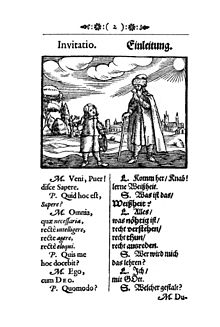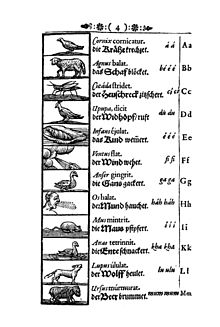Orbis sensualium pictus
The Orbis sensualium pictus (The Visible World), often referred to as Orbis pictus , was a textbook for young people and schools that was widespread in Europe from the 17th to the 19th centuries . The theologian Johann Amos Comenius from Moravia (then under the Bohemian Crown ) wrote the work during his time in Patak am Bodrog (today Sárospatak in Hungary ), where he worked as a teacher. The first trace of the "little book", as he called it, is a proof copy from 1653 with Latin texts under the title Lucidarium . The first bilingual edition appeared in Nuremberg in 1658 .
Edition and reception history
The first bilingual edition
In 1658, Michael Endter's publishing house in Nuremberg published a bilingual Latin-German edition, illustrated with woodcuts . On 309 pages in the format 10 × 16.5 cm plus lecture (foreword) and title index (index), Comenius describes the world - from God to insects. The mostly double-page articles are provided with a numbered illustration on the left and bilingual explanations on the right : The Latin text is compared with the translation into the language of the country of publication in two columns .
The individual articles move in a cycle across the entire cosmos, from God and the world, heaven and earth, through the elements, plants and animals to people. Their trades and professions, arts and sciences, virtues and vices are discussed as well as games, politics, wars, religions and punishments up to and including the Last Judgment. The presentation of the work ends in the resolution with the same illustration as in the introduction.
The German version goes back to the Nuremberg poet and writer Sigmund von Birken from the area around the Pegnese Order of Flowers , who thus significantly shaped the vocabulary of the time . In this context, Georg Philipp Harsdörffer (founder of the Flower Order) and Samuel Hartlib are also mentioned (Fijałkowski, p. 21).
Comenius's share in the illustration seems uncertain today; the woodcutter (identified as Paul Kreutzberger ) is said to have made these, while Comenius is said to have stayed in Lissa (today Leszno ) and Amsterdam (Fijałkowski, p. 18; this is based on the first Latin-German edition 1658 as the first edition, p . 17).
Further editions, dissemination and use in schools
The bilingual nature of the texts made it possible "with a little attention" to "learn Latin in a pleasant way". The picture book thus became both a Latin primer and a textbook for the German language.
Since there were no equivalent alternatives in the 17th and 18th centuries and because of its simple and "ingenious basic concept", the Orbis pictus spread very quickly across Europe. Over a period of more than 200 years, the work has been translated and edited into almost 20 languages. Around 200 editions were published.
There were not only bilingual editions with the national language of the respective country of publication, there were also polyglot editions, as early as 1666 (Latin - German - Italian - French) and for the first time with Comenius' mother tongue in 1685 (Latin - German - Czech - Hungarian) . Later editions refrained from revisions, "since the content and presentation of the work [...] appeared timeless in the sense of a world order willed by God".
In the 18th century, the Orbis pictus became the epitome of the textbook due to the lack of equivalent alternatives. The following quotes illustrate the importance of school teaching in the 18th century:
“But cheaply I don't have to forget the good, honest Orbis pictus, which fashion (for there is certainly also one in education) would have long been so happy to dispose of it, only that until then it had not known how to put a better book in its place. I have not spurned his teaching either, and I am sure that your little ones will also find teaching and enjoyment in them, provided that the punctured soul, and what looks like it, is cleared out of the way. "
"I love Comenius' books very much, especially the Orbis pictus, not because they are the best, but because we don't have any better ones"
In poetry and truth, Johann Wolfgang von Goethe described the Orbis pictus as the best children's book that had appeared up to that point. The work was valued by teachers and pupils alike and was used in schools at least until the second half of the 19th century.
Modern view
The work can be seen as one of the first multimedia teaching materials and as a forerunner of the modern image lexicon and comics . Comenius' idea was taken up again in 1995 in the interactive installation Orbis Pictus Revised .
Digitized facsimile editions
Latin - German
- Orbis sensualium pictus. The visible world , Nuremberg 1658 edition (the first 25 chapters, colored pictures, new texts). Bibliotheca Augustana.
- Orbis sensualium pictus , Nuremberg edition 1664, 150 plates, 315 pages as well as foreword and index
- The visible world , (three-column edition: Latin - German - Vocabulary) Nuremberg 1668
- Orbis sensualium pictus. The visible world , Nuremberg edition 1698 (150 chapters, epilogue, index). Heidelberg historical holdings - digital.
- Orbis pictus. The world in pictures , Vienna edition 1781 (82 chapters, 166 pages, with third column for vocabulary). Digital library Braunschweig.
English - Latin
- Orbis sensualium pictus. Visible World , London 1659 edition (151 chapters, 309 pages)
- Orbis sensualium pictus. Visible World , London 1777 edition (153 chapters, 197 pages)
Latin - Swedish - French
- The Synliga Werlden edition Stockholm 1775
Latin - Hungarian - German - Czech
- The Visible World in Four Languages , Typis Samuelis Brewer, 1685 (with introduction and registers)
- The world in pictures (Latin - Hungarian - German - "Slavic"), Pressburg (Pozsony) edition 1798
Latin - Czech - German - French
- Orbis senualium pictus. Swět w obrazích. The world in pictures. Le monde en tableaux , edition Prague 1845 (146 pages)
literature
- Robert Alt: Origin and meaning of the Orbis Pictus, a contribution to the history of the textbook . Akademie-Verlag, Berlin (East) 1970.
- Adam Fijałkowski: Orbis Pictus. Świat malowany Jana Amosa Komeńskiego. Orbis Pictus. The world in pictures by Johann Amos Comenius. University of Warsaw, Warsaw 2008, ISBN 978-83-924821-9-2 (bilingual: Polish and German ).
- Gerhard Michel: The importance of the Orbis Sensualium Pictus for school books in the context of the history of the school. In Paedagogica Historica 28 (1992), H. 2. pp. 235-251. doi: 10.1080 / 0030923920280205 .
- Kurt Pilz: The editions of the Orbis sensualium pictus. Johann Amos Comenius. A bibliography ( contributions to the history and culture of the city of Nuremberg , Volume 14), Nuremberg 1967.
Web links
: The Latin / German version from 1658 is presented here as an example.
- Orbis Pictus Brief description of an exhibition in 2009 presented by the Herder Institute Marburg
- OrbisSP_2013 - Virtues readings on ethics (chapter CIX – CXVII), part of the digital monument Comenius - student in Heidelberg - teacher of humanity
Individual evidence
- ^ A b c d e f Adam Fijałkowski: Lecture at the opening of the exhibition “Orbis Pictus. The World in Pictures by Johann Amos Comenius ”on May 6, 2010 in the BBF. In: Christian Ritzi (Red.): Mitteilungsblatt des Förderkreis Bibliothek für Bildungsgeschichtliche Forschung eV (Ed.), May 2010, ISSN 1860-3084 , pp. 15-21 ( PDF; 5.3 MB; pp. 17-23 , accessed on February 16, 2015).
- ↑ Johann Amos Comenius: Orbis sensualium pictus [...] The visible world. That is the pre-education and behavior of all worldly things and life-activities. Nuremberg 1658; Reprint Dortmund 1978 (= The bibliophile paperbacks , 30).
- ↑ a b Ilse Ziehensack: Children's and young people's literature of the second half of the 19th century from a historical perspective (with a focus on the German-speaking Austro-Hungarian monarchy). Diploma thesis at the University of Vienna , Vienna 2008, p. 25 ( PDF; 13.31 MB; p. 26 , accessed on February 16, 2015).
- ↑ a b c City and State Library Potsdam (Ed.): Book sponsorships. XVII. Selection catalog. The 18th Century - Enlightenment in Prussia. Potsdam 2010, p. 22 (explanation of the restoration of a copy of the Leutschau 1728 edition )
- ↑ a b Cf. Ludwig Keller (Ed.): Monthly Issues of the Comenius Society. XV. Volume I., Weidmannsche Buchhandlung, Berlin 1906, p. 174 ( digitized in the Internet Archive, origin: Harvard College Library. )

